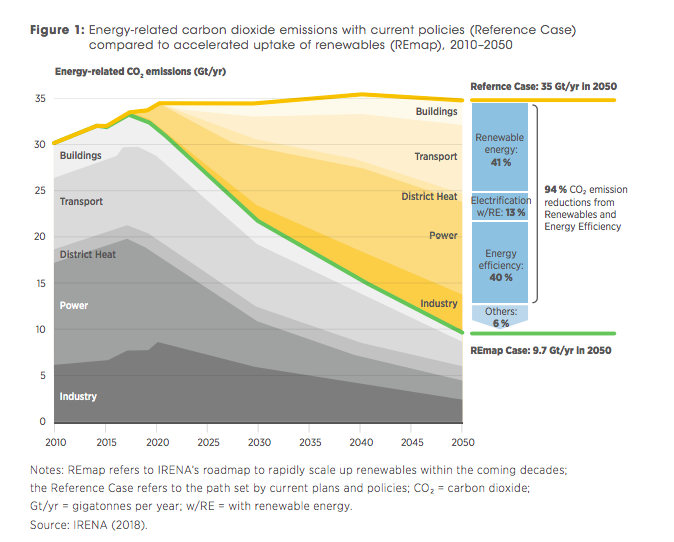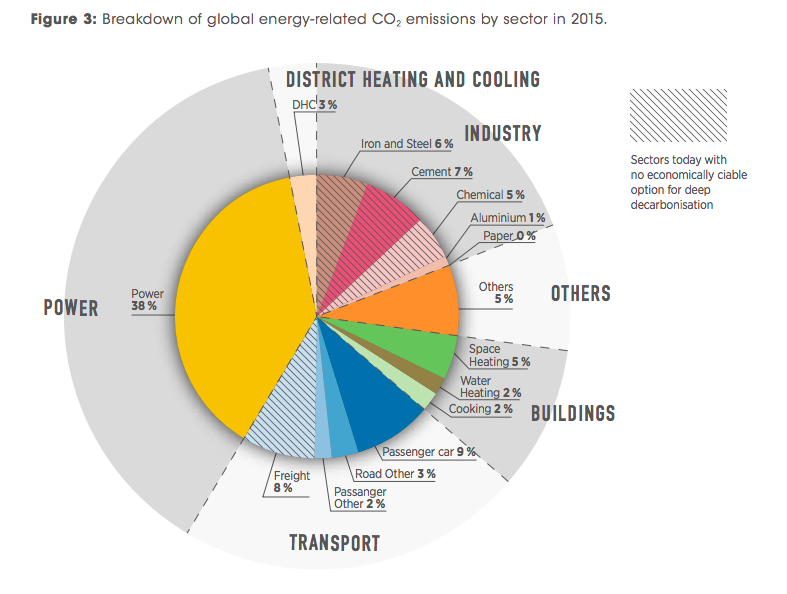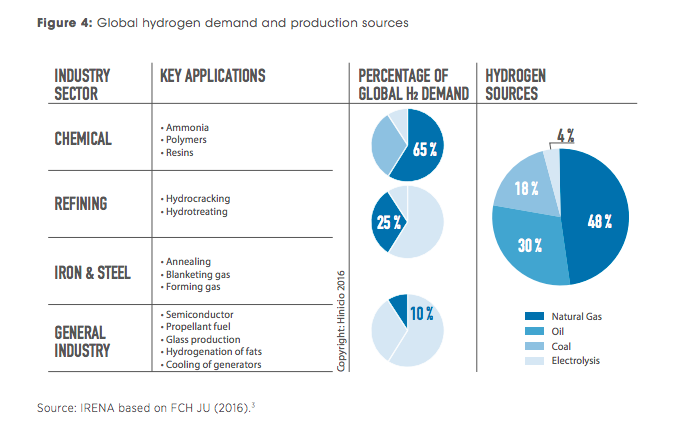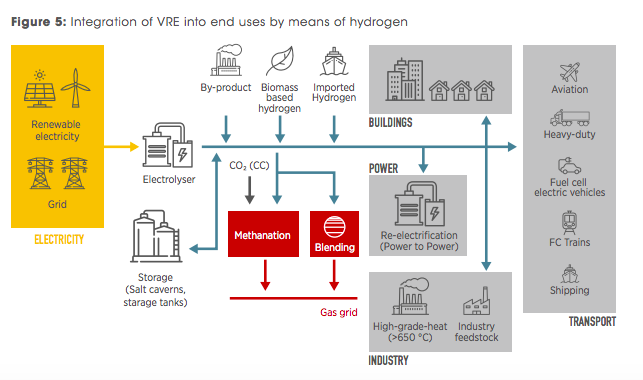INTERNATIONAL RENEWABLE ENERGY AGENCY (IRENA)
1 SETTING THE SCENE
The Paris Agreement aims to limit the rise in average global temperature to “well below 2 °C” in this century as compared to pre-industrial levels. Achieving this will require substantial emissions reductions across all sectors.

1.1 THE ENERGY TRANSITION: THE BIGGER PICTURE
To achieve the targets in the Paris Agreement, the global energy system must undergo a profound transformation from one largely based on fossil fuels to an efficient and renewable low-carbon energy system. According to analysis by the International Renewable Energy Agency (IRENA, 2018), over 90 % of the necessary global CO₂ emission reductions could come from these measures; renewable energy is expected to contribute 41 % of the required emission reductions directly and an additional 13 % through electrification (see Figure 1). To meet this objective, renewable energy’s share of global final energy consumption needs to increase from 18 % today to 65 % in 2050. Variable renewable energy in the power system, in particular wind and solar, will make up the vast majority of generation capacity (see Figure 2) and ca. 60 % of all electricity generation. The power system needs to become more flexible to economically integrate such large shares of variable generation.
Renewables could provide a large share of the world’s energy, with greater reliance on electricity and significant growth in installed power capacity by 2050.
Today, one-third of global energy-related emissions come from economic sectors for which there is presently no economic alternative to fossil fuels (IRENA, 2017a). These emissions originate mostly from the energy intensive industry sectors and freight transport (Figure 3).
Around one-third of energy-related emissions currently have no economically viable options for deep decarbonisation.
Hydrogen could be the “missing link” in the energy transition from a technical perspective: hydrogen from renewable electricity allows large amounts of renewable energy to be channelled from the power sector into sectors for which electrification (and hence decarbonisation) is otherwise difficult, such as transport, buildings and industry.
Hydrogen could thus play a key role in facilitating three positive outcomes: the decarbonisation of these sectors; the integration of large amounts of variable renewable energy (VRE); and the decoupling of VRE generation and consumption through the production of transportable hydrogen. However, hydrogen is not economically competitive at present, and therefore significant reductions in the cost of production and distribution need to take place for the decarbonisation of such sectors to take place.
This notion is becoming well recognised around the globe as a result of various developments, which include the need for deep decarbonisation (COP21), the increasing share and decreasing cost of renewable energy sources, wind and solar in particular, and the associated need for additional flexibility in power systems. In parallel, technological advancements and cost reductions in hydrogen-related technologies are increasing the competitiveness of hydrogen from renewable electricity.
1.2 HYDROGEN TODAY
The hydrogen industry is well established and has decades of experience in industry sectors using hydrogen as a feedstock. The hydrogen feedstock market has a total estimated value of USD 115 billion and is expected to grow significantly in the coming years, reaching USD 155 billion by 2022.2 In 2015 total global hydrogen demand was estimated to be 8 exajoules (EJ) (Hydrogen Council, 2017).
The largest share of hydrogen demand is from the chemicals sector for the production of ammonia and in refining for hydrocracking and desulphurisation of fuels. Other industry sectors also use hydrogen, such as producers of iron and steel, glass, electronics, specialty chemicals and bulk chemicals, but their combined share of total global demand is small (Figure 4).
Over 95 % of current hydrogen production is fossil-fuel based. Steam-methane reforming (SMR) is the most common way of producing hydrogen. Oil and coal gasification are also widely used, particularly in China and Australia, albeit to a lesser extent than SMR. Only around 4 % of global hydrogen supply is produced via electrolysis, mainly with chlor-alkali processes (Figure 4).
Petrochemical feedstocks account for most of the present hydrogen demand, and almost exclusively based on fossil fuels.
1.3 HYDROGEN IN THE ENERGY TRANSITION
Hydrogen is an energy carrier and not a source of energy. It can be produced from a wide variety of energy sources. Historically, hydrogen has been predominantly produced from fossil sources. In a low-carbon energy future, hydrogen offers new pathways to valorise renewable energy sources (see Section 2.1 for a discussion of possible pathways for the production of hydrogen from renewable power). This outlook report focuses on hydrogen produced from renewable electricity via electrolysis – referred to, more simply, as “hydrogen from renewable power”, or in industry parlance as “power-to-hydrogen”.
Hydrogen and electricity, as energy carriers, are complementary in the energy transition. Hydrogen from renewables has the technical potential to channel large amounts of renewable electricity to sectors for which decarbonisation is otherwise difficult:
Industry: Hydrogen produced from fossil fuels, currently widely used in several industry sectors (refineries, ammonia, bulk chemicals, etc.), technically can be substituted by hydrogen from renewables. In the longer term, hydrogen from renewables may replace fossil fuel-based feedstocks in these CO₂ emissions-intensive applications provided it can achieve economic competitiveness, which may require modification of existing processes.
Buildings and power: Hydrogen injected into the gas grid reduces natural gas consumption. Injection could be an additional revenue source for electrolyser operators beyond their hydrogen sales to mobility or industrial markets. In the short term, this could be of significant help to reach the volumes necessary to trigger cost reductions through economies of scale and improve the competitiveness of hydrogen from renewable power in the long term. A key advantage of this so-called “power-to-hydrogen” over electricity is the fact that hydrogen can be stored on a large scale, which enables the system to cope with large swings in demand as well as allowing for inter-seasonal storage to meet seasonal demand peaks (e. g. heat in winter).
Transport: When fuelled by hydrogen produced from renewables, fuel cell electric vehicles (FCEVs) are a low-carbon mobility option with the driving performance of conventional vehicles (driving range, refuelling time). FCEVs are complementary to battery electric vehicles (BEVs). They expand the market for electric mobility to high duty cycle segments (long-range or high utilisation rate vehicles, e. g. trucks, trains, buses, taxis, ferry boats, cruise ships, aviation, forklifts) where batteries are currently limited.
Power-to-hydrogen can provide flexibility to accommodate increasing shares of VRE into the power system.
An electrolyser is a device that splits water into hydrogen and oxygen using electricity. Electrolysers offer a flexible load that can provide low-cost balancing services (up and down) to the power system while producing hydrogen for mobility applications, industrial uses, or injection into the gas grid. The built-in storage capacity of downstream sectors (gas infrastructure, hydrogen supply chain etc.) can be used as a buffer to adjust hydrogen production (and hence electricity consumption) in real time depending on the needs of the power system, and to absorb VRE possibly over long periods thus allowing for seasonal storage.
In other words, hydrogen contributes to “sector coupling” between the electricity system and industry, buildings and transport, increasing the level of flexibility while facilitating the integration of VRE into the power system (Figure 5).
Hydrogen can facilitate coupling between electricity and buildings, transport and industry.
In the medium to long term, hydrogen could become a way to transport and distribute renewable energy over long distances, especially in those cases where the electricity grid has insufficient capacity or when it is too impractical or expensive to build. This might be the case with offshore wind, where hydrogen could be produced offshore and then be transported to the shore via natural gas pipelines, either converted existing offshore pipelines or newly installed, where the costs are lower than those for laying submarine cables.
Regions with abundant and cheap renewable energy sources could produce hydrogen for transport to regions with either limited potential or higher costs of renewable power generation. Transport of renewable energy via hydrogen could be developed at different scales, from local to international. This latter option is being investigated in several countries either with abundant renewable energy potential (e. g. Australia) or with limited indigenous renewable energy potential, such as Japan.
Hydrogen carriers, such as liquid organic hydrogen carriers (LOHCs) or ammonia, could be more suitable for long-distance transport than gaseous or liquid hydrogen. To date, however, pipelines remain the most economic route to transporting hydrogen in large volumes, hence “greening the gas grid” allows volumes to ramp up rapidly and provide the economies of scale necessary to reduce the cost of hydrogen.
Hydrogen could eventually become a way to transport renewable energy over long distances.
Download full version (PDF): Hydrogen from renewable power
About the International Renewable Energy Agency
www.irena.org
The International Renewable Energy Agency (IRENA) is an intergovernmental organisation that supports countries in their transition to a sustainable energy future, and serves as the principal platform for international cooperation, a centre of excellence, and a repository of policy, technology, resource and financial knowledge on renewable energy. IRENA promotes the widespread adoption and sustainable use of all forms of renewable energy, including bioenergy, geothermal, hydropower, ocean, solar and wind energy in the pursuit of sustainable development, energy access, energy security and low-carbon economic growth and prosperity.
Tags: CO2 Emissions, Electrolysers, Fossil Fuels, Greenhouse Gas, Hydrogen, International Renewable Energy Agency, IRENA, Paris Agreement, Renewable Energy









 RSS Feed
RSS Feed